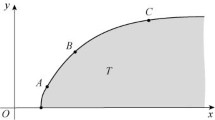Abstract
Up to recently, economists have had no good tools to measure the returns to scale of individual corporations in an industry. Data envelopment analysis (DEA) is a linear programming technique for determining the efficiency frontier (the envelope) to the inputs and outputs of a collection of individual corporations or other productive units. While DEA offers an avenue for calculating the returns to scale of individual corporations, the approach has been riddled by mathematical complications arising from the possibility of alternate optima. The present paper develops theory for calculating the entire range of these alternate optima. Furthermore, in a quite ambitions empirical application, DEA is employed to determine the time path of returns to scale of all publicly held U.S. computer companies over the time period 1980–1991. For the great majority of companies, a unique time path is obtained; only in less than 4 percent of the linear programming calculations is an entire range of alternate optima obtained. The results indicate that the computer industry was polarized into two camps: large aging corporations with decreasing returns to scale, and swarms of small upstart companies with advanced technology exhibiting increasing returns to scale.
Similar content being viewed by others
References
Arthur WB (1988) Self-reinforcing mechanisms in economics. In: PW Anderson and KJ Arrow (eds) The economy as an evolving complex system, pp. 9–31. Santa Fe Institute Studies in The Science of Complexity. Addison Wesley Publishing Company
Arthur WB (1989) Competing technologies, increasing returns, and lock-in by historical events. The Economic Journal 99: 116–131
Arthur WB (1990) Positive feedback in the economy. Scientific American 262: 92–99
Arthur WB, Ermoliev YM, Kaniovski YM (1987) Path-dependent processes and the emergence of macro-structure. European Journal of Operational Research 30: 294–303
Banker RD (1984) Estimating most productive scale size using data envelopment analysis. European Journal of Operational Research 17: 35–44
Banker RD, Bardhan I, Cooper WW (1995) A note on returns of scale in DEA. European Journal of Operational Research
Banker RD, Charnes A, Cooper WW (1984) Some models for estimating technical and scale inefficiencies in data envelopment analysis. Management Science 30: 1078–1092
Banker RD, Thrall RM (1992) Estimation of returns to scale using data envelopment analysis. European Journal of Operational Research 62: 74–84
Bass FM (1969) A new product growth model for consumer durables. Management Science 15: 215–227
Bernard J, Cantner U, Westermann G (1996) Technological leadership and variety: A data envelopment analysis for the French machinery industry. Annals of Operations Research
Brooke A, Kendrick D, Meeraus A (1988) GAMS: A user's guide. The Scientific Press: Redwood City, Calif.
Chang K, Guh Y (1991) Linear production functions and the data envelopment analysis. European Journal of Operational Research 52: 215–223
Charnes A, Cooper WW, Rhodes E (1978) Measuring the efficiency of decision making units. European Journal of Operational Research 2: 429–444
Charnes A, Cooper WW, Golany B, Seiford L, Stutz J (1985) Foundations of data envelopment analysis for Pareto-Koopmans efficient empirical production functions. Journal of Econometrics 30: 91–107
Debreu G (1959) Theory of value. Wiley: New York
Fare R, Grosskopf S, Lovell CAK (1985) The measurement of efficiency of production, Kluwer Nijhoff: Boston
Ganley JA, Cubbin JS (1992) Public sector efficiency measurement: Applications of data envelopment analysis. Elsevier Science Publishers: Amsterdam
Golany B, Thore S (1995) Restricted best practice selection in DEA: an overview with a case study evaluating the socio-economic performance of nations. Annals of Operations Research.
Marshall A (1890, 8th edn 1920) Principles of economics. Macmillan: London
Norton JA, Bass FM (1987) A diffusion theory model of adoption and substitution for successive generations of high-technology products. Management Science 33: 1069–1086
Penrose ET (1959) The theory of the growth of the firm. Basil Backwell. Oxford
Seiford L, Thrall RM (1990) Recent developments in DEA: The mathematical programming approach to frontier analysis. Journal of Econometrics 46: 7–38
Thompson GL, Thore S (1992) Computational economics: Economic modeling with optimization software. The Scientific Press, South San Francisco, Calif.
Thore S, Kozmetsky G, Phillips F (1994) DEA of financial statements data: The US computer industry. Journal of Productivity Analysis 5: 229–248
Thore S, Phillips F, Ruefli TW, Yue P (1995) DEA and the management of the product cycle: The US computer industry. Computers & Operations Research
Author information
Authors and Affiliations
Rights and permissions
About this article
Cite this article
Thore, S. Economies of scale in the US computer industry: An empirical investigation using data envelopment analysis. J Evol Econ 6, 199–216 (1996). https://doi.org/10.1007/BF01202594
Issue Date:
DOI: https://doi.org/10.1007/BF01202594




